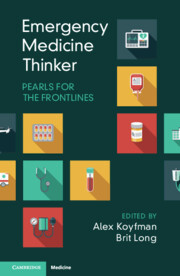Book contents
- Emergency Medicine Thinker
- Emergency Medicine Thinker
- Copyright page
- Contents
- Contributors
- Introduction
- Section 1 Decision-Making
- 1 On Deciding to Not Decide
- 2 What Makes Emergency Medicine Decision-Making Unique and Why?
- 3 Pediatric Emergency Medicine Approach: Be Vigilant but Be Reasonable
- 4 Decision-Making in Emergency Medicine
- 5 Emergency Medicine Medical Decision-Making
- 6 Decisions
- 7 Emergency Thinking and Behavior
- 8 Emergency Medicine Decision-Making
- 9 Emergency Medicine Decision-Making
- 10 Emergency Medicine Thinking and Cognitive Load Considerations
- 11 Decision-Making in Uncertainty
- 12 Unlearning and Thinking Differently
- 13 Decision-Making in Emergency Medicine
- 14 An Object in Motion
- 15 Too Little or Too Much?
- 16 Decision-Making in Emergency Medicine
- 17 Medical Decision-Making in the Emergency Department: Balancing the Patient’s Health with the Clinician’s Perception of Risk
- Section 2 Clinical Pearls
- Index
- References
1 - On Deciding to Not Decide
from Section 1 - Decision-Making
Published online by Cambridge University Press: 14 March 2025
- Emergency Medicine Thinker
- Emergency Medicine Thinker
- Copyright page
- Contents
- Contributors
- Introduction
- Section 1 Decision-Making
- 1 On Deciding to Not Decide
- 2 What Makes Emergency Medicine Decision-Making Unique and Why?
- 3 Pediatric Emergency Medicine Approach: Be Vigilant but Be Reasonable
- 4 Decision-Making in Emergency Medicine
- 5 Emergency Medicine Medical Decision-Making
- 6 Decisions
- 7 Emergency Thinking and Behavior
- 8 Emergency Medicine Decision-Making
- 9 Emergency Medicine Decision-Making
- 10 Emergency Medicine Thinking and Cognitive Load Considerations
- 11 Decision-Making in Uncertainty
- 12 Unlearning and Thinking Differently
- 13 Decision-Making in Emergency Medicine
- 14 An Object in Motion
- 15 Too Little or Too Much?
- 16 Decision-Making in Emergency Medicine
- 17 Medical Decision-Making in the Emergency Department: Balancing the Patient’s Health with the Clinician’s Perception of Risk
- Section 2 Clinical Pearls
- Index
- References
Summary
The number of decisions an emergency clinician must make during a shift can quickly become overwhelming. Given the frequent interruptions, the suboptimal conditions, and the high levels of stress and uncertainty, it is extremely challenging for an emergency clinician to make all these decisions well – in some cases, it might even be impossible. Cognitive load theory suggests that all humans have a limited “bandwidth” (or “cognitive capacity”) that we can harness to make decisions and perform tasks. This bandwidth is typically used in three distinct ways. Intrinsic cognitive load is the bandwidth we devote to making a specific decision or performing a particular task. Extraneous cognitive load is the bandwidth that leeches into the environment around the decision or task we’re trying to accomplish; this bandwidth is spent buffering distractions and handling unrelated tasks. Finally, germane cognitive load is the bandwidth we use to learn and solidify a thought process or form a new skill.
- Type
- Chapter
- Information
- Emergency Medicine ThinkerPearls for the Frontlines, pp. 5 - 12Publisher: Cambridge University PressPrint publication year: 2025

